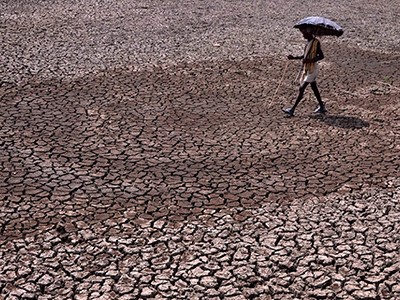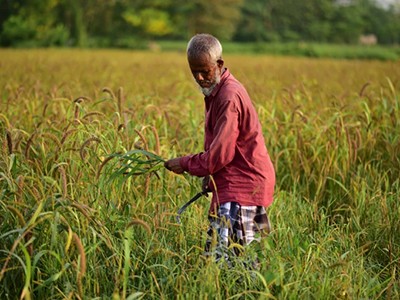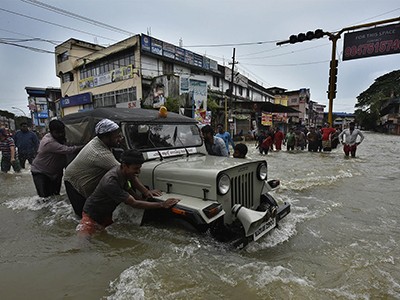India’s monsoon season is approaching, and much of the country is experiencing a heatwave. Worse weather, including floods and cyclones, might follow. The India Meteorological Department has forecast “above normal” monsoon rainfall this year. India is holding general elections, and dealing with the intensifying impacts of climate change must be at the top of the incoming government’s agenda. Understanding monsoon rainfall is crucial to both people and the economy. Last year, India had significant losses in wheat yields owing to untimely heavy rains.
As a data scientist who, with my colleagues, has dissected 40 years of rainfall data across more than 4,500 Indian sub-districts (tehsils), I have seen changes in how and where monsoon rains fall. Monsoons — whose name comes from the Arabic word mausim, meaning season — are periodic changes in wind direction. Typically, between June and September, the Indian subcontinent experiences heavy rains during the southwest monsoon, caused by moist winds drawn up from oceans in the southwest. From October to December, during the northeast monsoon, air flowing from the northeast triggers rains in southern India.
Grand plan to drought-proof India could reduce rainfall
In January, the Council on Energy, Environment and Water (CEEW), a public-policy research institution in New Delhi where I work, published its report detailing how monsoons are becoming more erratic across India. Even adjacent tehsils are seeing different trends in rainfall — hindering grass-roots preparedness at local levels.
Many tehsils in historically arid states, such as Rajasthan, Gujarat and central Maharashtra, experienced 10–30% more southwest-monsoon rains in the past ten years (2012–22) than during the three preceding decades (1982–2011). Key sectors, such as agriculture and water management, have been affected. By contrast, around 11% of Indian tehsils have seen a decrease in southwest-monsoon rainfall of more than 10%. Most lie in the agriculturally important Indo-Gangetic plains, the fragile Indian Himalayan region (home to a high number of endemic plant species) and the northeastern states, where some of the world’s wettest places are found.
Over the past two decades, Indian governments have invested in weather-forecasting systems and developed national and state-level climate-action plans. These have been helpful. But as the impacts of climate change worsen, more action is needed. It is time to combine a policy push, high-quality research and granular risk assessment to build resilience against increasingly erratic rainfall patterns.
How a warming Pacific Ocean and climate change will impact agriculture
First, decentralize. India is a vast country with six major climatic zones. The national government has mandated that all states and union territories should assess climate risks and develop mitigation and adaptation strategies for the rest of the decade. All 766 Indian districts should do the same, on the basis of microclimatic changes in monsoon patterns and socio-economic data; these plans should address crop insurance, power supplies and groundwater quality, for example. This year, the CEEW has supported Thane, a coastal city in Maharashtra, in developing its first risk-informed heat action plan. This framework can serve as a model for others.
Second, strengthen farming. Agriculture and related sectors are the biggest employers in the Indian economy, and they contributed 18% of the country’s gross domestic product in 2022–23. Government responses to crop losses must move past just relief and compensation. Instead, farmers’ ability to cope must be bolstered, for example by adjusting crop growth and harvest phases, relying on climate-resilient seeds and updating crop calendars, which are developed jointly by agricultural and meteorological agencies and provide farmers with weekly weather information for the planting, sowing and harvesting periods of crops grown in their districts.
How India is battling deadly rain storms as climate change bites
These calendars must incorporate shifting monsoon patterns. Efforts are under way in some states, including Assam, which in 2022 asked the Indian Council of Agricultural Research, a research institute in New Delhi, to evaluate rainfall and temperature changes and determine the optimal approach to calendar revision. Others should follow suit.
Third, disaggregate data. Scientists studying the South Asian climate must examine monsoon variability with greater granularity and map risks and impacts in different sectors across space and time. The distribution of rainfall throughout the season is more important than the total amount. Adaptation strategies for 2030 currently rely on climate projections for 2050 and 2100 — shorter-term estimates are needed, as has been recognized by the governmental scheme Atmosphere & Climate Research-Modelling Observing Systems & Services.
Decision makers must recognize that floods and droughts can occur in the same district, in the same season. More local data should be collected through automated weather stations and community-science initiatives. For example, more than 200 public schools in Kerala are using weather stations to record 24-hour rain data, humidity, wind speed and direction, in an effort to understand the microclimate.
The Indian government, at all levels, must tackle erratic monsoons and ‘climate-proof’ the economy. The lessons learnt could help countries in the global south experiencing extreme rainfall and floods, from Afghanistan to Kenya, Brazil and Indonesia.
Competing Interests
The author declares no competing interests.




